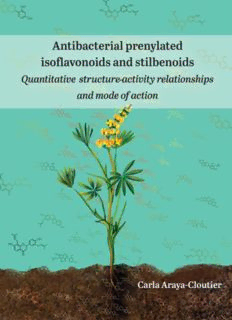Table Of ContentPropositions
1. The site of action of antibacterial prenylated phenolic compounds
is the cytoplasmic membrane.
(this thesis)
2. After hydrophobicity, molecular shape is the most important
feature of antibacterial prenylated phenolic compounds.
(this thesis)
3. Evaluation of assumptions advances science more than their
prolonged use.
4. Personalized medicine may be effective, but not efficient.
5. “Carbon neutrality” is at its best a delayed “carbon correction”.
6. The current use of referenda in the EU does not serve democracy.
7. Confirmation bias flourishes in the social media environment.
Propositions belonging to the thesis entitled:
“ANTIBACTERIAL PRENYLATED ISOFLAVONOIDS AND STILBENOIDS
Quantitative structure-activity relationships and mode of action.”
Carla M. Araya-Cloutier
Wageningen, 13 April 2017
Antibacterial prenylated isoflavonoids
and stilbenoids
Quantitative structure-activity relationships and
mode of action
Carla Araya-Cloutier
Thesis committee
Promotors
Prof. Dr H. Gruppen
Professor of Food Chemistry
Wageningen University & Research
Co-promotors
Dr J-P. Vincken
Associate professor, Laboratory of Food Chemistry
Wageningen University & Research
Dr H.M.W. den Besten
Associate professor, Laboratory of Food Microbiology
Wageningen University & Research
Other members
Prof. Dr J.T. Zuilhof, Wageningen University & Research
Prof. Dr O.P. Kuipers, University of Groningen
Prof. Dr B.H. ter Kuile, University of Amsterdam
Prof. Dr P.J.G.M. de Wit, Wageningen University & Research
This research was conducted under the auspices of the Graduate School VLAG (Advanced
studies in Food Technology, Agrobiotechnology, Nutrition and Health Sciences).
Antibacterial prenylated isoflavonoids
and stilbenoids
Quantitative structure-activity relationships and
mode of action
Carla Araya-Cloutier
Thesis
submitted in fulfilment of the requirements for the degree of doctor
at Wageningen University
by the authority of the Rector Magnificus,
Prof. Dr A.P.J. Mol,
in the presence of the
Thesis Committee appointed by the Academic Board
to be defended in public
on Thursday 13 April 2017
at 11 a.m. in the Aula.
Carla Araya-Cloutier
Antibacterial prenylated isoflavonoids and stilbenoids
Quantitative structure-activity relationships and mode of action,
200 pages.
PhD thesis, Wageningen University, Wageningen, the Netherlands (2017)
With references, with summary in English
ISBN 978-94-6343-036-4
DOI 10.18174/400170
Abstract
Prenylated phenolic compounds, i.e. those bearing a C -isoprenoid (prenyl) substituent,
5
are abundant in plants from the Fabaceae (legume) family and are potential natural
antibacterial agents against resistant pathogenic bacteria. To understand the
antibacterial properties of these compounds, (quantitative) structure-activity relationships
and mode of action of these molecules were investigated against Gram positive and
negative bacteria.
Compounds belonging to the flavonoid, isoflavonoid and stilbenoid classes were
studied. Antibacterial activity was modulated by the (sub)class of phenolic compound, as
well as by the configuration, position and number of prenyl groups. Prenylated
isoflavones were found to be better antibacterials than prenylated pterocarpans and
prenylated stilbenoids. It was also shown that chain prenylation increased the
antibacterial activity more than pyran-ring prenylation. Diprenylated compounds were
among the most active antibacterials with minimum inhibitory concentrations of less than
10 µg/mL against Listeria monocytogenes. The main molecular characteristics defining
antibacterial activity were molecular shape (including flexibility and globularity) and
hydrophobicity. Regarding the mode of action of these compounds, it was shown that
prenylated phenolic compounds can disrupt the integrity of the membrane by
permeabilization very quickly. Interestingly, some good antibacterial prenylated
(iso)flavonoids showed good permeabilization capacity whereas others not (including
diprenylated molecules), highlighting potential differences in their interactions with the
bacterial membrane. Likewise, it was shown that Gram negative intrinsic resistance
towards prenylated phenolic compounds is primarily due to the activity of efflux pump
systems and that it can be overcome by using an efflux pump inhibitor in combination
with antibacterial prenylated compounds. Last, in vitro production of prenylated phenolic
compounds was performed with microbial prenyltransferase SrCloQ and novel C- and
O-prenylated compounds were produced.
Table of contents
Chapter 1 General Introduction 1
Chapter 2 The position of prenylation of isoflavonoids and 29
stilbenoids from legumes (Fabaceae) modulates the
antimicrobial activity against Gram positive pathogens
Chapter 3 Rapid membrane permeabilization of Listeria 65
monocytogenes and Escherichia coli induced by
prenylated phenolic compounds: influence of skeleton
structure and prenyl configuration
Chapter 4 QSAR-based molecular signatures of prenylated 97
(iso)flavonoids underlying antimicrobial potency
against and membrane-disruption in Gram positive
and Gram negative bacteria: Listeria monocytogenes
and Escherichia coli
Chapter 5 Structural basis for non-genuine phenolic acceptor 135
substrate specificity of Streptomyces roseochromogenes
prenyltransferase CloQ from the ABBA/PT-barrel
superfamily
Chapter 6 General Discussion 161
Summary 189
Acknowledgments 193
About the author 197
Description:Carla M. Araya-Cloutier. Wageningen mode of action. Carla Araya-Cloutier prenylated phenolic compounds: influence of skeleton structure and

